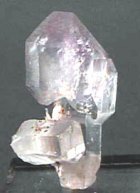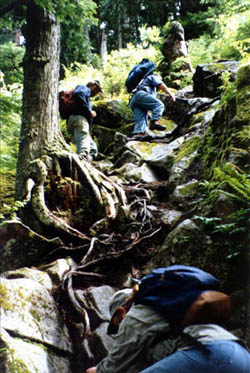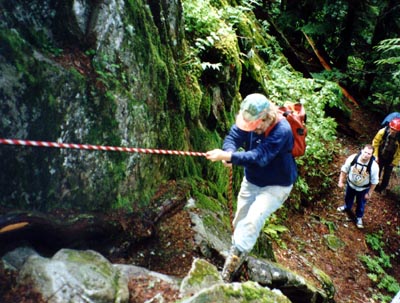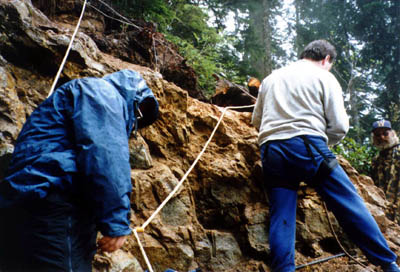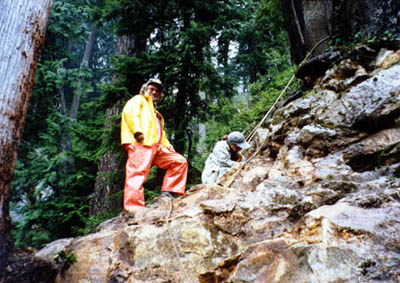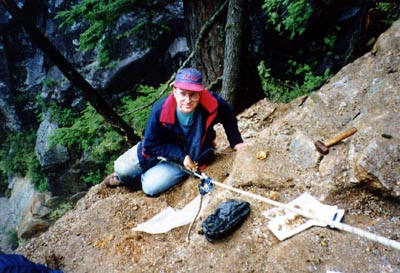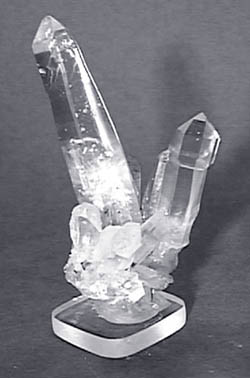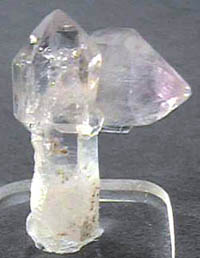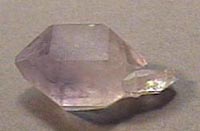 |
|||
|
|||
|
Copyright
The Spruce Claim Amethyst Sceptre
IntroductionSpruce Claim, located east of North Bend, Washington, is well known for spectacular quartz and pyrite combination plates. Specimens from this deposit are found in private and museum collections world-wide. Bob Jackson of Geology Adventures acquired Spruce Claim in the early 1980's and has been mining the deposit ever since. Bob also has been organising fee trips for collectors to the site for many years.I had collected at Spruce Claim on Bob's fee trips several times in the past, and have always come back with plenty of specimens. On June 24, 1996, Bob offered a special trip to collect in a new amethyst sceptre zone discovered the previous fall. I and five other collectors signed up for this trip.
Background GeologyThe Spruce claim deposit consists of 2 breccia pipes, which are part of a larger series of breccia pipes extending along a six mile stretch of the Middle Fork of the Snoqualmie River. These breccia pipes intrude into the Snoqualmie batholith, and include the crystal producing deposits of Katie Belle, Pedro and Big Chief.The Spruce Claim breccia pipes are called Spruce and West Fault, and are exposed on a vertical cliff and cut by a fault. Quartz crystals are abundant in vugs at both outcrops. Associated minerals include ankerite, barite, bravoitite, calcite, chalcopyrite, chlorite, cosalite, epidote, galena, gold, malachite, pyrite, siderite and sphalerite. Quartz crystals found in the West Fault are typically slender, and sometimes sceptred. Quartz crystals in the Spruce are thicker and often associated with pyrite. In recent years the collecting has focused on the Spruce pipe, since West Fault has become buried by talis. The amethyst sceptre zone is part of the Spruce pipe, and was discovered above the main showing. Until this discovery, sceptre crystals were relatively uncommon in the Spruce pipe.
Our TripThis particular trip was an Explorers Group trip, which meant that the participants had to have been on 2 or more of Bob's trips in the past. On regular Spruce Claim collecting trips, we would meet Bob in North Bend and follow him to the site. On this trip, Bob arranged to meet us at the parking area at the base of the hill below the claim. Bob had sent us crude maps of the approximately 25 miles of forest service roads leading to the site. The forest service roads in the area can be rough at times, but if you have a high clearance vehicle, you do not need four-wheel drive to get to the site.Arriving at North Bend half an hour before we were to meet, I looked at the map, and immediately set out on the wrong road. I finally realised the road I was on did not lead to the forest service roads, so I backtracked and eventually found the right route. My unintentional detour had wasted some time, and I needed to hurry to get to the meeting place before the others ascended. So I travelled more quickly than I usually would over the rough roads, trying unsuccessfully to avoid puddles, potholes and rocks. Fortunately I did not suffer a break down, although my suspension squeaked for weeks afterwards from the mud which had worked its way into it.
I arrived at the meeting place late, but was not the last to arrive. Eventually the group was complete, and we set off. The hike up to Spruce is steep, where you climb a 1000 feet in about a quarter mile. Over the years Bob has carved out a crude trail to the site. Although in some areas Bob has hung rope to assist with the climbing, the route is basically a steep hike and there is no true rock climbing. The trail often is covered with cedar bark, which can be slippery, when wet, and Bob holds the trip, rain or shine. It was drizzling, so the trail was slippery and the underbrush was wet. Our group, with many rest stops, took about 1/2 hour to hike to the main Spruce deposit. The route to the amethyst sceptre zone diverts from the normal Spruce trail to climb over the main showing. The site was about 200 feet above the main Spruce deposit.
As soon as we had been assigned vugs, we attached the safety ropes and worked our way over to our collecting area. My vug had a narrow opening, and went back about arm's length. It was filled with wet clay and gravel, with much of that gravel comprised of loose quartz crystals. Working through the gravel, I soon began to remove loose quartz singles and plates. Many of these crystals were sceptred. Very early on I pulled out a nice small cluster with a quartz sceptre growing beside a longer quartz crystal.
It took me some time to clean out the loose material in that vug and get to the plates on the wall. My experience with wall plates at Spruce in the past was that the wall rock was hard and it took considerable effort to peel a plate away. I was pleasantly surprised when on this trip I was able to remove most of the wall plates from the vug with a screwdriver and some light chiselling. This exposure was much closer to the surface, so weathering had softened the host rock. Unfortunately, it had also destroyed any pyrite crystals. As I worked my vug, I looked at the sceptres I pulled out to see if they were amethyst. For the most part, they looked colourless, although I would not be sure until I got them home and cleaned up. Then I noticed my first amethyst sceptre. It was a short stubby crystal, a double terminated floater, with a subtle purple hue. The vug I was working on turned out to be fairly prolific for quartz sceptre plates. After I cleaned it out, I moved on and worked some of the smaller vugs in the vicinity. In total, I found about a half dozen single amethyst sceptre crystals, numerous quartz sceptre plates, a bag full of quartz sceptre singles, and lots of regular quartz crystals and plates. The amethyst sceptres I found were all single crystals, about half which were double terminated floaters. Their sized ranged from 0.5"-1.5". In all of them their purple colour was very subtle, interspersed in a cloudy white area in the sceptre head. We collected for about 6 hours at the site. After wrapping the specimens and packing them, we still had to make it down the wet, slippery trail. With the weight of the crystals on your back, the decent is tricky, and our progress was slow. However, it doesn't seem so bad when your pack is full of specimens you collected that day! Now three years later, I still have not cleaned all the specimens.
UpdateThe amethyst sceptre zone has continued as Bob worked the bench down, and amethyst and pyrite plates have now been found. I'm told that one in 25 visitors on Bob's regular trips now find amethyst sceptres.
Contact InformationGeology Adventures offers regular trips to Spruce Claim in the summer. For more information, visit his website at geologyadventures.com, or send e-mail to Bob at: geologyadventur@seanet.com.
References
Permission is given to freely reprint this article from the Canadian Rockhound for non-commercial and educational purposes, provided the author and the Canadian Rockhound are acknowledged, and that the website URL address of the Canadian Rockhound is given. The article may not be edited or rewritten to change its meaning or substance without the author's permission. To contact the author, please use the e-mail address provided.
|
||||||||

Copyright © 2000 Canadian Rockhound
Magazine Issues |
News & Events |
Junior Rockhound |
Resources
|
||||||||
